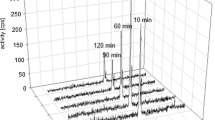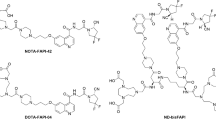Abstract
Purpose
Stimulator of interferon genes (STING) protein plays a vital role in the immune surveillance of tumor microenvironment. Monitoring STING expression in tumors benefits the relevant STING therapy. This study aimed to develop a novel 18F-labeled agonist, dimeric amidobenzimidazole (diABZI), and firstly evaluate the feasibility of noninvasive positron emission tomography (PET) imaging of STING expression in the tumor microenvironment.
Methods
An analog of the STING agonist NOTA-DABI was synthesized and labeled with 18F via Al18F-NOTA complexation (denoted as [18F]F-DABI). Physicochemical properties, STING protein-binding affinity, and specificity of [18F]F-DABI were evaluated using cell uptake and docking assays. In vivo small-animal PET imaging and biodistribution studies of [18F]F-DABI in tumor-bearing mice were performed to verify the pharmacokinetics and tumor targeting ability. The correlation between tumor uptake and STING expression was also analyzed.
Results
[18F]F-DABI was produced conveniently with high radiochemical yield (44 ± 15%), radiochemical purity (> 97%) and molar activity (15–30 GBq/μmol). In vitro binding assays demonstrated that [18F]F-DABI has a favorable affinity and specificity for STING with a KD of 12.98 ± 2.07 nM. In vivo studies demonstrated the specificity of [18F]F-DABI for PET imaging of STING expression with B16F10 tumor uptake of 10.93 ± 0.93%ID/g, which was significantly different from that of blocking groups (3.13 ± 0.88%ID/g, ***p < 0.0001). Furthermore, tumor uptake of [18F]F-DABI was well positively correlated with STING expression in different tumor types. Biodistribution results demonstrated that [18F]F-DABI was predominately uptaken in the liver and intestines, indicating its hepatobiliary elimination.
Conclusion
This proof-of-concept study demonstrated a STING-binding radioligand for PET imaging, which could be used as a potential companion diagnostic tool for related STING-agonist therapies.
Graphical abstract








Similar content being viewed by others
Abbreviations
- STING:
-
Stimulator of interferon genes
- diABZI:
-
Dimeric amidobenzimidazole
- PET:
-
Positron emission tomography
- cGAS:
-
Cyclic guanosine monophosphate-adenosine monophosphate synthase
- IFN-I:
-
Type I interferons
- IHC:
-
Immunohistochemistry
- HPLC:
-
High-performance liquid chromatography
- NMR:
-
Nuclear magnetic resonance
- DMXAA:
-
Vadimezan
- FBS:
-
Fetal bovine serum
- SDS-PAGE:
-
Sodium dodecyl-sulfate polyacrylamide gel electrophoresis
- %ID/g:
-
Injected dose per gram of tissue
- ROIs:
-
Regions of interest
- p.i.:
-
Post-injection
- i.t.:
-
Intratumorally injected
- CDN:
-
Cyclic dinucleotide
References
Sanmamed MF, Chen L. A paradigm shift in cancer immunotherapy: from enhancement to normalization. Cell. 2018;175:313–26.
Haslam A, Prasad V. Estimation of the percentage of US patients with cancer who are eligible for and respond to checkpoint inhibitor immunotherapy drugs. JAMA Netw Open. 2019;2:e192535.
Yarchoan M, Hopkins A, Jaffee EM. Tumor mutational burden and response rate to PD-1 inhibition. N Engl J Med. 2017;377:2500.
Motwani M, Pesiridis S, Fitzgerald KA. DNA sensing by the cGAS–STING pathway in health and disease. Nat Rev Genet. 2019;20:657–74.
Garland KM, Sheehy TL, Wilson JT. Chemical and biomolecular strategies for STING pathway activation in cancer immunotherapy. Chem Rev. 2022;122:5977–6039.
Yum S, Li M, Frankel AE, Chen ZJ. Roles of the cGAS-STING pathway in cancer immunosurveillance and immunotherapy. Annu Rev Cancer Biol. 2019;3:323–44.
Gao P, Ascano M, Wu Y, Barchet W, Gaffney BL, Zillinger T, et al. Cyclic [G(2′,5′)pA(3′,5′)p] is the metazoan second messenger produced by DNA-activated cyclic GMP-AMP synthase. Cell. 2013;153:1094–107.
Corrales L, Glickman LH, McWhirter SM, Kanne DB, Sivick KE, Katibah GE, et al. Direct Activation of STING in the tumor microenvironment leads to potent and systemic tumor regression and immunity. Cell Rep. 2015;11:1018–30.
Fu J, Kanne DB, Leong M, Glickman LH, McWhirter SM, Lemmens E, et al. STING agonist formulated cancer vaccines can cure established tumors resistant to PD-1 blockade. Sci Transl Med. 2015;7(283):283ra52.
Challa SV, Zhou S, Sheri A, Padmanabhan S, Meher G, Gimi R, et al. Preclinical studies of SB 11285, a novel STING agonist for immuno-oncology. JCO. 2017;35:14616–14616.
Kwon J, Bakhoum SF. The cytosolic DNA-sensing cGAS–STING pathway in cancer. Cancer Discov. 2020;10:26–39.
Pan B-S, Perera SA, Piesvaux JA, Presland JP, Schroeder GK, Cumming JN, et al. An orally available non-nucleotide STING agonist with antitumor activity. Science. 2020;369:eaba6098.
Chen Q, Boire A, Jin X, Valiente M, Er EE, Lopez-Soto A, et al. Carcinoma–astrocyte gap junctions promote brain metastasis by cGAMP transfer. Nature. 2016;533:493–8.
Lemos H, Mohamed E, Huang L, Ou R, Pacholczyk G, Arbab AS, et al. STING promotes the growth of tumors characterized by low antigenicity via IDO activation. Cancer Res. 2016;76:2076–81.
Liang D, Xiao-Feng H, Guan-Jun D, Er-Ling H, Sheng C, Ting-Ting W, et al. Activated STING enhances tregs infiltration in the HPV-related carcinogenesis of tongue squamous cells via the c-jun/CCL22 signal. Biochim Biophys Acta. 2015;1852:2494–503.
Lim S-O, Li C-W, Xia W, Cha J-H, Chan L-C, Wu Y, et al. Deubiquitination and Stabilization of PD-L1 by CSN5. Cancer Cell. 2016;30:925–39.
Sivick KE, Desbien AL, Glickman LH, Reiner GL, Corrales L, Surh NH, et al. Magnitude of therapeutic STING activation determines CD8+ T cell-mediated anti-tumor immunity. Cell Rep. 2018;25:3074–85.
Chon HJ, Kim H, Noh JH, Yang H, Lee WS, Kong SJ, et al. STING Signaling is a potential immunotherapeutic target in colorectal cancer. J Cancer. 2019;10:4932–8.
Raaby Gammelgaard K, Sandfeld-Paulsen B, Godsk SH, Demuth C, Meldgaard P, Sorensen BS, et al. cGAS-STING pathway expression as a prognostic tool in NSCLC. Transl Lung Cancer Res. 2021;10:340–54.
Woo S-R, Fuertes MB, Corrales L, Spranger S, Furdyna MJ, Leung MYK, et al. STING-dependent cytosolic DNA sensing mediates innate immune recognition of immunogenic tumors. Immunity. 2014;41:830–42.
Ishikawa H, Barber GN. STING is An Endoplasmic reticulum adaptor that facilitates innate immune signalling. Nature. 2008;455:674–8.
Flood BA, Higgs EF, Li S, Luke JJ, Gajewski TF. STING pathway agonism as a cancer therapeutic. Immunol Rev. 2019;290:24–38.
Hu Q, Wu J, Ren Y, Wu X, Gao L, Wang G, et al. Degree of STING activation is associated with disease outcomes. Gut. 2020;69:792.2-794.
Jiang M, Chen P, Wang L, Li W, Chen B, Liu Y, et al. cGAS-STING, an important pathway in cancer immunotherapy. J Hematol Oncol. 2020;13:81.
Topalian SL, Taube JM, Anders RA, Pardoll DM. Mechanism-driven biomarkers to guide immune checkpoint blockade in cancer therapy. Nat Rev Cancer. 2016;16:275–87.
van der Leun AM, Thommen DS, Schumacher TN. CD8+ T cell states in human cancer: insights from single-cell analysis. Nat Rev Cancer. 2020;20:218–32.
Bensch F, van der Veen EL, Lub-de Hooge MN, Jorritsma-Smit A, Boellaard R, Kok IC, et al. 89Zr-atezolizumab imaging as a non-invasive approach to assess clinical response to PD-L1 blockade in cancer. Nat Med. 2018;24:1852–8.
Xing Y, Chand G, Liu C, Cook GJR, O’Doherty J, Zhao L, et al. Early phase I study of a 99mTc-Labeled Anti-Programmed Death Ligand-1 (PD-L1) single-domain antibody in SPECT/CT assessment of PD-L1 expression in non–small cell lung cancer. J Nucl Med. 2019;60:1213–20.
Zhou X, Jiang J, Yang X, Liu T, Ding J, Nimmagadda S, et al. First-in-humans evaluation of a PD-L1–binding peptide PET radiotracer in non–small cell lung cancer patients. J Nucl Med. 2022;63:536–42.
Ramanjulu JM, Pesiridis GS, Yang J, Concha N, Singhaus R, Zhang S-Y, et al. Design of amidobenzimidazole STING receptor agonists with systemic activity. Nature. 2018;564:439–43.
Burdette DL, Monroe KM, Sotelo-Troha K, Iwig JS, Eckert B, Hyodo M, et al. STING is a direct innate immune sensor of cyclic di-GMP. Nature. 2011;478:515–8.
Meric-Bernstam F, Sandhu SK, Hamid O, Spreafico A, Kasper S, Dummer R, et al. Phase Ib study of MIW815 (ADU-S100) in combination with spartalizumab (PDR001) in patients (pts) with advanced/metastatic solid tumors or lymphomas. JCO. 2019;37:2507–2507.
Funding
This study was financially supported by the Major Research Plan of the National Natural Science Foundation of China (91959122), National Natural Science Foundation of China (81901805, 21976150, 21906135), Joint Fund of the National Natural Science Foundation of China—China National Nuclear Corporation for Nuclear Technology Innovation (U1967222), and Fundamental Research Funds for the Central Universities of China (20720210115).
Author information
Authors and Affiliations
Contributions
Conceptualization: Xianzhong Zhang, Jianyang Fang, Zhide Guo; methodology: Jianyang Fang, Lixia Feng, Lingxin Meng, Lumei Huang, Huanhuan Liu, Jingchao Li and Rongqiang Zhuang formal analysis and investigation: Jianyang Fang, Xiaobo Wang, Deliang Zhang; writing (original draft preparation): Jianyang Fang; writing (review and editing): Xianzhong Zhang, Zhide Guo, Xiaobo Wang; funding acquisition: Xianzhong Zhang, Zhide Guo.
Corresponding authors
Ethics declarations
Ethics approval
All animal studies were performed according to the guidelines of the Animal Care Committee of Xiamen University.
Conflict of interest
The authors declare no competing interests.
Additional information
Publisher's note
Springer Nature remains neutral with regard to jurisdictional claims in published maps and institutional affiliations.
This article is part of the Topical Collection on Preclinical Imaging
Jianyang Fang, Lixia Feng, and Lingxin Meng are first authors who contributed equally to this work.
Supplementary Information
Below is the link to the electronic supplementary material.
Rights and permissions
Springer Nature or its licensor holds exclusive rights to this article under a publishing agreement with the author(s) or other rightsholder(s); author self-archiving of the accepted manuscript version of this article is solely governed by the terms of such publishing agreement and applicable law.
About this article
Cite this article
Fang, J., Feng, L., Meng, L. et al. A novel 18F-labeled agonist for PET imaging of stimulator of interferon gene expression in tumor-bearing mice. Eur J Nucl Med Mol Imaging 50, 27–37 (2022). https://doi.org/10.1007/s00259-022-05959-7
Received:
Accepted:
Published:
Issue Date:
DOI: https://doi.org/10.1007/s00259-022-05959-7




